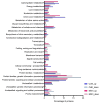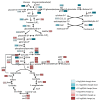Changes in the Spore Proteome of Bacillus cereus in Response to Introduction of Plasmids
- PMID: 36144297
- PMCID: PMC9503168
- DOI: 10.3390/microorganisms10091695
Changes in the Spore Proteome of Bacillus cereus in Response to Introduction of Plasmids
Abstract
Fluorescent fusion proteins were expressed in Bacillus cereus to visualize the germinosome by introducing a plasmid that carries fluorescent fusion proteins of germinant receptor GerR subunits or germinosome scaffold protein GerD. The effects of plasmid insertion and recombinant protein expression on the spore proteome were investigated. Proteomic analysis showed that overexpression of the target proteins had negligible effects on the spore proteome. However, plasmid-bearing spores displayed dramatic abundance changes in spore proteins involved in signaling and metabolism. Our findings indicate that the introduction of a plasmid alone alters the spore protein composition dramatically, with 993 proteins significantly down-regulated and 415 proteins significantly up-regulated among 3323 identified proteins. This shows that empty vector controls are more appropriate to compare proteome changes due to plasmid-encoded genes than is the wild-type strain, when using plasmid-based genetic tools. Therefore, researchers should keep in mind that molecular cloning techniques can alter more than their intended targets in a biological system, and interpret results with this in mind.
Keywords: effects of plasmids; fluorescent proteins; germinant receptor; proteomics.
Conflict of interest statement
The authors declare no conflict of interest.
Figures






Similar articles
-
Visualization of SpoVAEa Protein Dynamics in Dormant Spores of Bacillus cereus and Dynamic Changes in Their Germinosomes and SpoVAEa during Germination.Microbiol Spectr. 2022 Jun 29;10(3):e0066622. doi: 10.1128/spectrum.00666-22. Epub 2022 May 11. Microbiol Spectr. 2022. PMID: 35543559 Free PMC article.
-
Dynamics of Germinosome Formation and FRET-Based Analysis of Interactions between GerD and Germinant Receptor Subunits in Bacillus cereus Spores.Int J Mol Sci. 2021 Oct 18;22(20):11230. doi: 10.3390/ijms222011230. Int J Mol Sci. 2021. PMID: 34681888 Free PMC article.
-
Genomic versus Plasmid-Borne Expression of Germinant Receptor Proteins in Bacillus cereus Strain 14579.Microorganisms. 2022 Sep 2;10(9):1774. doi: 10.3390/microorganisms10091774. Microorganisms. 2022. PMID: 36144376 Free PMC article.
-
Spore Germination.Microbiol Spectr. 2015 Dec;3(6). doi: 10.1128/microbiolspec.TBS-0014-2012. Microbiol Spectr. 2015. PMID: 27337279 Review.
-
Proteomics and microscopy tools for the study of antimicrobial resistance and germination mechanisms of bacterial spores.Food Microbiol. 2019 Aug;81:89-96. doi: 10.1016/j.fm.2018.03.006. Epub 2018 Mar 14. Food Microbiol. 2019. PMID: 30910091 Review.
Cited by
-
The megaplasmid pCER270 of Bacillus cereus emetic strain affects the timing of the sporulation process, spore resistance properties, and germination.Appl Environ Microbiol. 2024 Sep 18;90(9):e0102924. doi: 10.1128/aem.01029-24. Epub 2024 Aug 19. Appl Environ Microbiol. 2024. PMID: 39158315 Free PMC article.
-
Germination of Bacillus spores by LiCl.J Bacteriol. 2025 Mar 20;207(3):e0051024. doi: 10.1128/jb.00510-24. Epub 2025 Feb 27. J Bacteriol. 2025. PMID: 40013823 Free PMC article.
References
-
- Lablaine A., Serrano M., Bressuire-Isoard C., Chamot S., Bornard I., Carlin F., Henriques A.O., Broussolle V. The morphogenetic protein CotE positions exosporium proteins CotY and ExsY during sporulation of Bacillus cereus. MSphere. 2021;6:e00007–e00021. doi: 10.1128/mSphere.00007-21. - DOI - PMC - PubMed
-
- Bassi D., Cappa F., Cocconcelli P.S. Water and Cations Flux during Sporulation and Germination. Caister Academic Press; Norfolk, UK: 2012.
Grants and funding
LinkOut - more resources
Full Text Sources
Molecular Biology Databases

